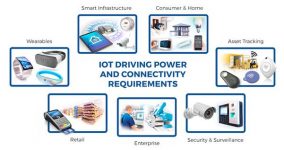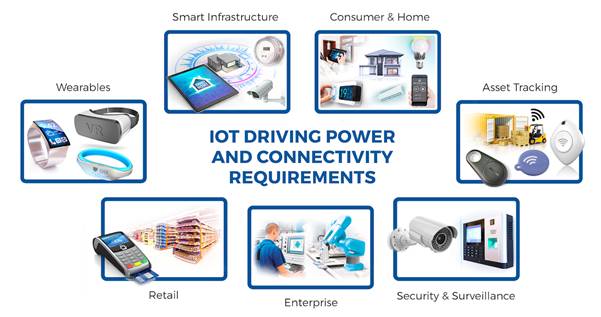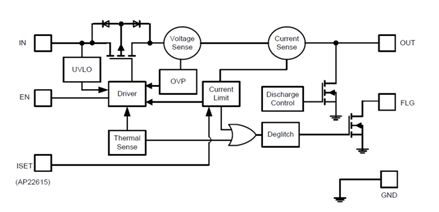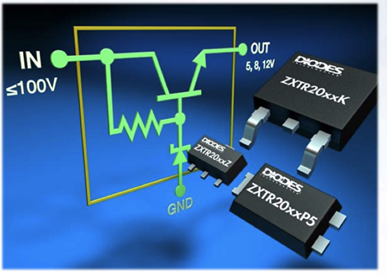
Powering IoT end devices via USB or PoE for greater convenience and economy
“IoT end devices are typically characterized by extremely low power consumption, compact devices that may be self-powered or designed to last for years on a single coin cell battery. The Internet of Things actually encompasses a wide variety of devices, including smart sensors, data logging devices, smart building controllers, security devices such as intruder detectors and network cameras, and many other retail, enterprise, and infrastructure product applications ( figure 1).
“
By Benjamin Tang, Product Marketing Manager, and Mingyu Qu, Head of Strategic Marketing, Diodes Corporation
Wired data connection methods such as USB and Ethernet can also provide an effective and convenient power supply solution for the most demanding IoT terminal devices.
IoT end devices are typically characterized by extremely low power consumption, compact devices that may be self-powered or designed to last for years on a single coin cell battery. The Internet of Things actually encompasses a wide variety of devices, including smart sensors, data logging devices, smart building controllers, security devices such as intruder detectors and network cameras, and many other retail, enterprise, and infrastructure product applications ( figure 1).

Figure 1: The application range of IoT products is expanding, and some of the devices included therein require power that cannot be met by small batteries.[数据源:Diodes 公司]
Many of these devices have huge energy demands that cannot be met by small batteries. They might be powered by powerful embedded processors that process data natively to reduce network latency and improve privacy, or simply reduce the final cost. They may have a mechanical subsystem, like a camera with pan-tilt-zoom (PTZ) capability, which can easily add another few watts to the power requirements of the overall system. In these product applications, small batteries cannot meet the highest power demands of the system, or provide insufficient power for the required runtime, requiring regular battery replacement.
A larger battery could be considered, but would add to the overall size, weight, and bill of materials. Powering from nearby AC power lines, if possible, eliminates the need for batteries, but this adds extra complexity with the addition of extra power cords and AC-DC power conversion within the unit. An external power transformer can be used to solve this design complexity, but the problem of additional cost remains unsolved.
If the end device uses wired USB or Ethernet connectivity, designers can take advantage of the respective power delivery capabilities. Power over Ethernet (PoE) and USB Power Delivery use the same cable for power and data transfer, thus avoiding the disadvantages associated with batteries and AC power. Both USB Power Delivery and PoE have established standards and are powered at low voltages, making it safer for the end user to operate the device.
USB Power Delivery Specifications
A common USB 2.0 connection consisting of two data lines (D+ and D-), a 5V DC power supply, and a ground line can typically provide 500mA. This is sufficient to power end devices requiring 2.5W or less. A USB 3.0 port delivers 900mA, and the latest USB Type-C® ports can deliver 1.5A or 3.0A in a 5V configuration, increasing the maximum power to 15W.
USB Power Delivery (USB PD) is an independent standard that uses the data cable in the USB Type-C connector for power supply. This allows compliant devices to coordinate with the power supply to deliver the power they need. This could be 9V or 15V (3A) or 20V (5A), increasing the maximum power of the USB connection to 100W.
Power over Ethernet Type
Existing Ethernet infrastructure can support IoT end devices plugged in at any point in the network as a PoE Powered Device (PD) while using a minimum amount of new cabling (if any). A Power Sourcing Equipment (PSE) can be a device such as a PoE switch or hub that uses one or more data pairs in the cable to power the wire. The maximum data transmission distance specified in the Ethernet standard is 100 meters, but a PoE extender can be inserted to extend the connection distance.
A PoE injector can also be used to power cables from a non-PoE switch. The PoE splitter separates the power from the Ethernet cable and outputs power to non-PoE terminal devices.
As shown in Table 1, there are several generations of PoE devices in service today. The first generation of Type 1 PoE, defined as the standard IEEE 802.3af, supports a power budget of up to 15.4W, powered by the PSE. The subsequent 802.3at Type-2 standard, PoE+, supports up to 30W and is backward compatible with Type 1 PD.
The latest 802.3bt standard includes Type-3, PoE++ (or UPoE) devices with a maximum power budget of 60W, and 100W Type-4 devices. 802.3af and 802.3at use up to two pairs of wires in a Cat 5/5e cable, while 802.3bt requires a Cat 6 (balanced) cable, using all four pairs. This configuration greatly reduces power consumption in the cable, allowing more power to reach the PD. It also reduces the minimum allowable PD standby power, improving support for low-power designs.
|
IEEE Standard |
PoE Type |
Port power supply |
Maximum current |
|
802.3af |
Type 1 |
15.4W |
350mA |
|
802.3at |
Type 2 |
30W |
600mA |
|
802.3bt |
Type 3 |
60W |
600mA |
|
802.3bt |
Type 4 |
100W |
960mA |
Table 1: PoE standards.
End Device Design for USB or PoE
A traditional USB 2.0, USB 3.2, or USB Type-C port provides a relatively stable 5V DC power source directly from a dedicated power cable in the connector. A DC-DC converter such as Diodes’ AP61100 5V, 1A step-down converter is an ideal device to stably supply power to IoT end devices operating from USB power.
In the PoE power supply system, each pair of cables must be equipped with transformers, bridge rectifiers, PD controllers and DC-DC converters to supply power to the load. DC-DC converters for PoE auxiliary DC bus product applications, including Diodes’ AP62200 (18V/2A) and AP63200 (32V/2A) synchronous buck converters. These products have a wide input voltage range and feature low on-resistance high-side and low-side MOSFETs to maximize energy efficiency. Constant-on-time (COT) control in the AP62200 series and peak current mode control with an integrated compensation loop in the AP63200 series provide higher performance while minimizing external component count.
basic protection
USB provides complex functions that help with system management, such as ensuring that each device consumes only the power it needs. The negotiated communication protocol and power curve specified in the standard enable the communication between the power supply and the end device to use the power under the best conditions.
On the other hand, there is no handshake or data exchange before power is supplied to the device. This contributes to the affordability and plug-and-play simplicity of USB, eliminating any need for auxiliary power when powering the unit, but also may present a risk of failure. One example is if the device tries to demand too much power, or it creates a short circuit.
Designers can use a power switch such as the Diodes AP22811, AP22804, or AP22814 to prevent these situations. These devices provide overcurrent, short circuit and thermal protection with automatic recovery. Also built-in reverse current and voltage protection. With a maximum current rating of 3A and a minimum on-resistance of 50mΩ, they provide a robust and efficient way to protect USB ports. The AP22652 or AP22653 can also adjust the current limit to a maximum value of 2.1A with a maximum on-resistance of 65mΩ. Another option is the AP22615 (Figure 2) or the AP22815, with 28V overvoltage protection and fixed and adjustable current limit options.

Figure 2: The AP22615 provides integrated protection for USB powered devices.[数据源:Diodes 公司]
The USB switch also provides a soft-start function, which can control the rise time of the output voltage to protect the power supply and load. Additional safety features prevent inrush currents, minimizing critical failures.
Higher power PoE
Designers need to pay close attention to the power efficiency of high-power IoT product applications, such as access control and video devices, in order to provide the best performance in limited space and cost. High-efficiency devices must be selected at each stage of the power system to maximize the benefits of high density and integration. Diodes designed the ZXTR2000 series of linear regulators for 48V DC power systems including PoE product applications (Figure 3). These regulators integrate transistors, Zener diodes and resistors in a single package, reducing component count and board space requirements.

Figure 3: The XTR200 series provides an integrated solution for high-power PoE product applications.[数据源:Diodes 公司]
in conclusion
Designers of IoT end devices can now consider issues other than offline, wireless power transfer, and battery power to meet demanding product application requirements. Wired standards such as USB and PoE provide convenient and flexible options to overcome power challenges with off-the-shelf DC-DC converters, voltage regulators and protection devices.
The Links: EL640480-AG1 SKM400GB123D


